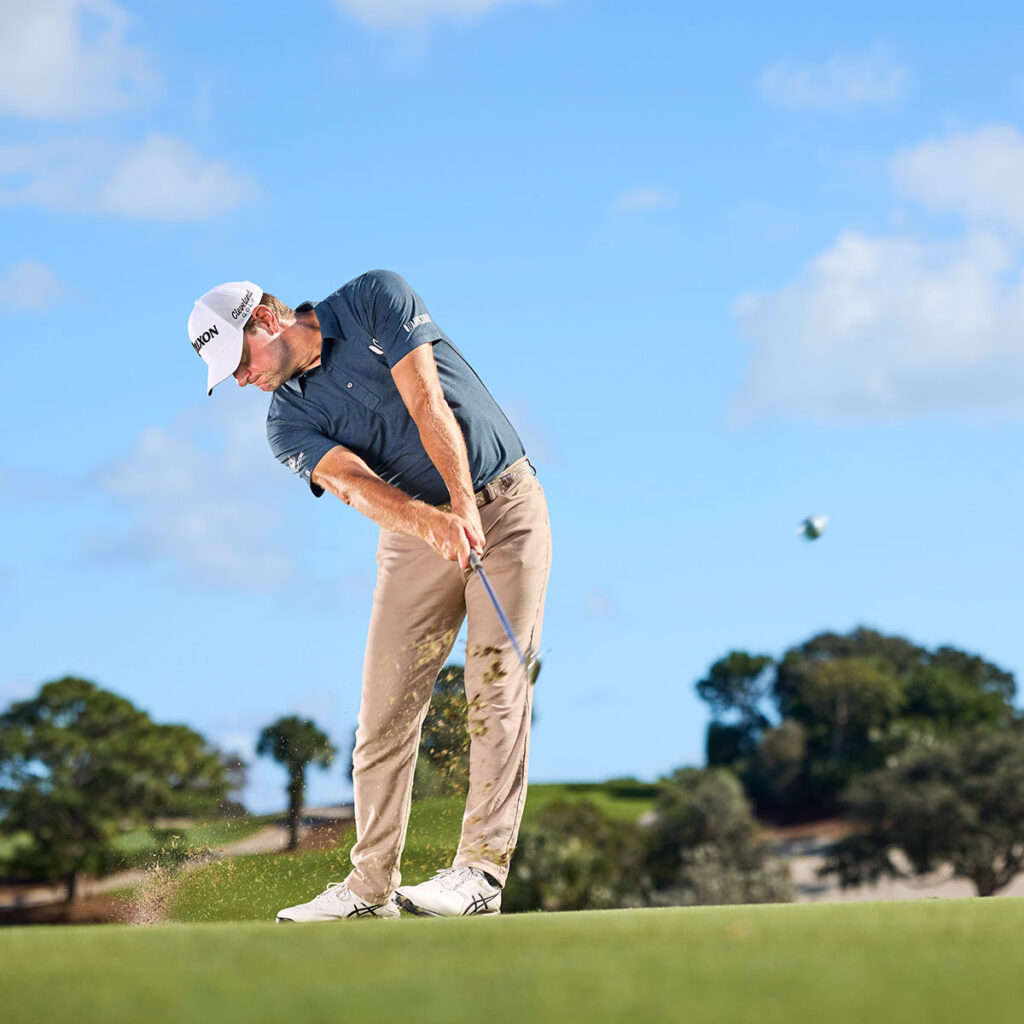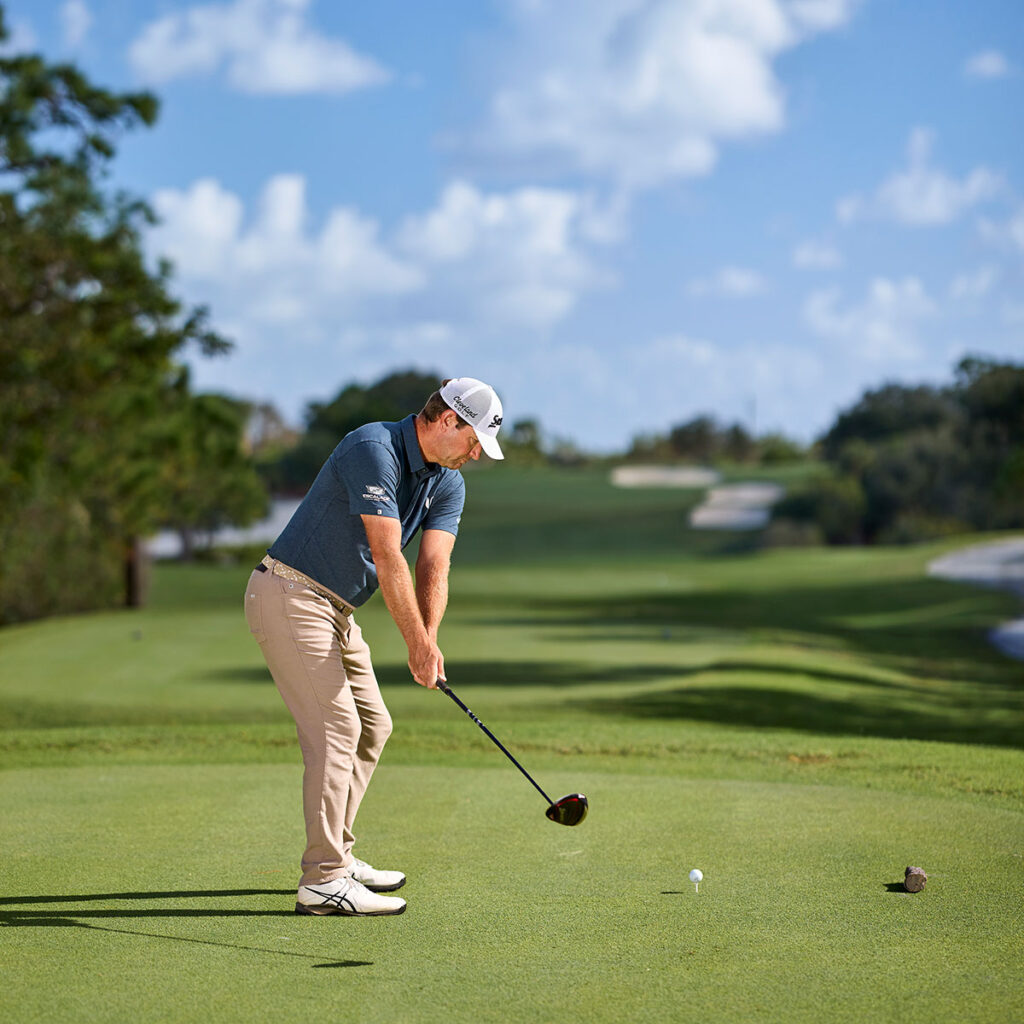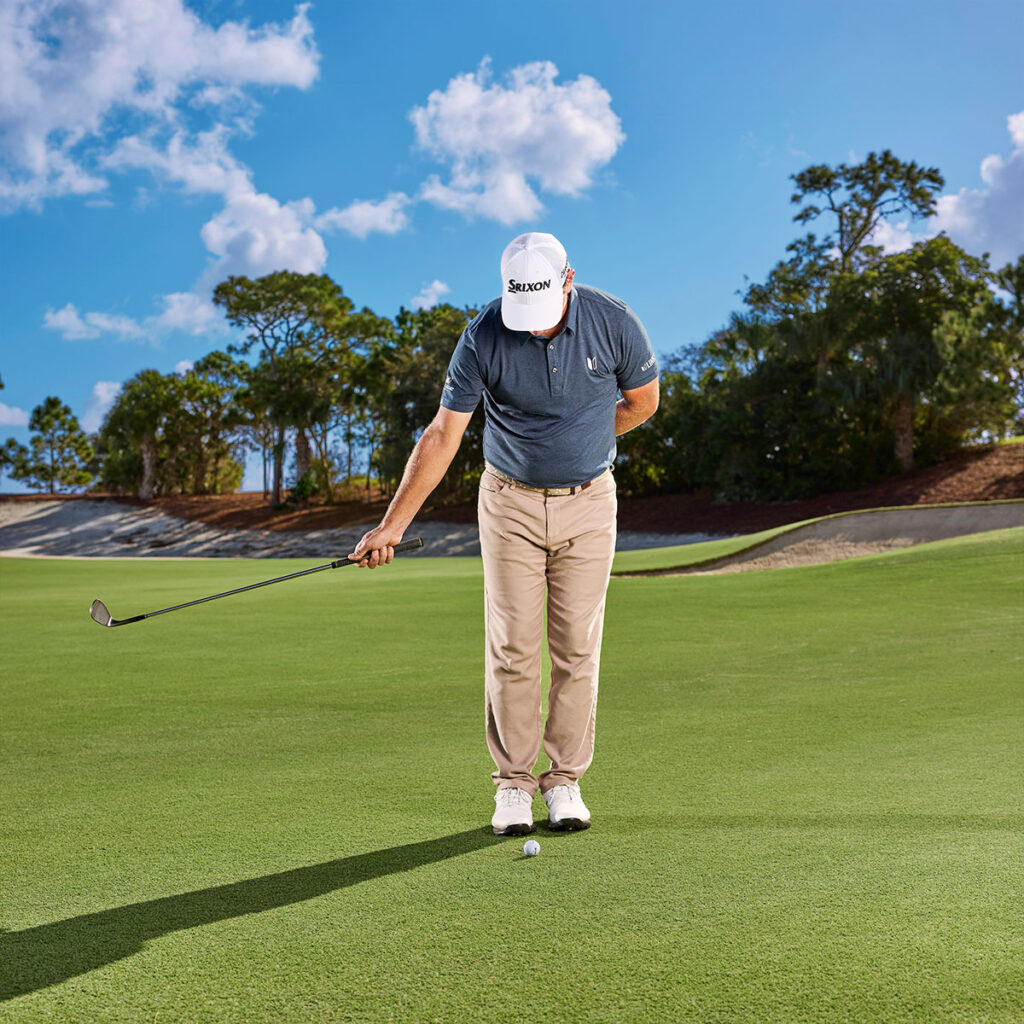2009 US Open champion Lucas Glover has risen from the ashes, and he wants to share his revelations to help you, too
Photographs by Jensen Larson
Following a T-79 finish at the AT&T Byron Nelson last May, only his fifth made cut in 13 tournaments, Lucas Glover had dropped to 147th in the World Golf Ranking. For the six-time PGA Tour winner and 2009 US Open champion, his spirit wasn’t at rock bottom- – but it was close. Glover, 44, wasn’t finding much joy in golf, and his decade-long struggle with the putting yips left him battling just to play on the weekends.
“Too hard-headed and stubborn to give up,” Glover says he kept telling himself that if he beat the yips, he would get his game back. But to do that, something drastic had to be done. He had already spent thousands on training aids and tried nearly every style of putter, grip and stroke imaginable. He even won the 2021 John Deere Classic by putting inside six feet with his eyes closed. Realising that nothing else seemed to cure the affliction, including marathon practice sessions, he finally turned to a longer putter.
“No one has made more three-footers in practice over the past 10 years,” says Glover, who has missed 77 putts from three feet and in since the start of the 2020-2021 season. “But you can’t simulate the feeling [of the yips] in practice.”

Inspired by Adam Scott’s success with a 45-inch putter, Glover learned how to use a similar one by watching YouTube videos of Scott’s technique. The split-hands grip and bent-over posture made it much easier to isolate the shoulders. The sweeping, broomstick-like motion of the longer club greatly reduced the twitchy, involuntary hand-and-wrist tension that cursed his putting. “It was a complete new motor skill and brain function,” Glover says.
About the time of the switch, Glover met Jason Kuhn, a former Navy SEAL turned performance coach. His specialty is helping others overcome the yips, which Kuhn experienced on the baseball mound in college, once throwing six wild pitches in a single inning.
“Jason’s message to me was, ‘You’re the furthest thing from being mentally weak. You came to work every day and competed,’” Glover says. “He said, ‘I’m going to give you a way to beat this, and since you’ve gone through it already, you’re going to be better for it.’ Boy, did I need to hear that.”
The combination of the putter and Kuhn’s guidance helped produce one of the most remarkable in-season turnarounds in PGA Tour history. In a six-week stretch between July and August, Glover finished in the top-six five times and won in back-to-back weeks at the Wyndham Championship and FedEx St Jude Championship. Glover was top 15 in strokes gained/putting in both wins, which catapulted him to 30th in the world ranking. “It’s just an entirely different mindset,” Glover says. “It’s fun to practise putting again.”
Even better, the improvement seems contagious. Working with Florida-based swing coach Jason Baile, one of Golf Digest’s 50 Best Teachers in America, Glover has found ways to boost nearly every facet of his game. Here, they want to share some of the things you can take from his restoration to start playing
more to your potential. As a finishing touch, Kuhn has a little advice to help fix your putting if your stroke has become a little jittery.

Putting basics: Focus on stability and fluidity
The yips first showed up about four years after Glover won the 2009 US Open. “I would equate
it to a panic attack,” he says. “Your heart is racing; you’re not feeling like your motor functions are working. Something you’ve been doing your whole life, now you feel like you can’t move the putter.” The shorter the putt, the more his hands and wrists would tense up, leading to a very quick backstroke and poor speed control. To counter that, the 45-inch broomstick-style putter forced Glover to radically change his setup and stroke.
By separating his hands on the grip, he now stands much wider and further away from the ball, which helps stabilise his lower body. He’s also more bent over the ball, which makes it easier to set the lead arm parallel to his target line and get his eyes more over the ball.
“If you stabilise the lower body, the upper body can be freer, and I think that’s what helped Lucas,” Baile says. “It’s called disassociation. When you create something stable, the next piece – in this case Lucas’ shoulders – can be more mobile. That’s a good tip for amateurs, regardless of what putter you use – putt with a stable lower body, a mobile upper body and very still eyes.”
Glover found a way to distract himself from the initial putter movement by focusing entirely on the connection he feels when the putter meets the ball. It’s like closing his eyes, and it promotes more freedom in the stroke. It also helps Glover to stay in constant motion, as evidenced by his unusual pre-shot routine. Glover will stretch his trail hand away from the bottom grip, but as soon as the hand rejoins the shaft, he starts the backstroke [above]. “It feels really smooth,” he says.
Got the yips? Do this
“Get your stroke on video and see if you can identify the mechanical interruption point where the yip is
occurring. It should be fairly obvious,” says Jason Kuhn, a specialist on curing the yips.
“Once you identify it, put all your conscious effort into that moment in the stroke and attack it. In Lucas’ case, the yip was at the start of his backswing. Because he’s a very rhythmic player, we worked on practical ways to get more fluidity in the way he took the club back.”

Shift your body (and divot hole) forward for better iron shots
Until last year, Glover felt like he had to knock every approach shot stiff to shoot a good score. He would hit a 5-iron to 25 feet but would think it wasn’t close enough because of his struggles with the putter. The yips were starting to negatively impact his irons swings.
“His comment to me would be, ‘It’s just not solid. It’s just not solid,’” Baile says. “The thump was gone.”
By “thump”, Glover meant he was looking for better compression between the ball, the club and then the turf. To get it, Baile first had Glover spin the clubface more open at address to counter his stronger grip. The face had become too closed, and for a player who liked to draw it like Glover, he would instinctively have to rock his torso behind the ball to start it right of the target line and curve it on line. This would push the low point of his divot further and further back (the low point for most pros is at least a few inches after the club makes contact with the ball). Ironically, Glover had fallen into the same bad habit of many amateur golfers – he was hanging back on his trail side at the start of the downswing.

To get Glover’s upper body moving more forward and creating a feeling that he’s on top of the ball at impact, Baile had him start hitting left-to-right shots (cuts). Baile asked Glover to take a divot as far left and forward of the ball as he could and feel like he could “spit straight down into the middle of his divot hole” at impact. That swing thought prompted Glover to shift his body forward earlier on the downswing, and that gave the feeling of his torso hovering over the ball at impact.
They started working on the cut ball flight at the Memorial Tournament last June, and it didn’t take long before Glover got into a groove. Two months later in his win at the Wyndham, he put on a ball-striking clinic, ranking first in strokes gained/approach – picking up 8.48 shots on the rest of the field. He also was No.1 in greens in regulation, missing only seven all week.
Another drill that helps Glover improve his weight shift in the transition from backswing to downswing is to place a half-full water bottle on the ground just inside his right ankle. The goal is to knock the bottle over with his right leg before the clubhead makes contact with the ball [above and below]. This move causes the trail ankle and leg to bank forward, and the upper body to transition towards the target earlier so that he can hit down and through the ball and compress it.
“I’ve always been a divot guy,” Glover says. “That’s how I compress it so well. It’s not so much the look of the divot as it is the feel of it – it’s not steep and it’s not sticky; the club goes through the ground easily, and the hole is more towards the target than directly under the ball.”

Work on side bend for better contact
“If you watch Lucas’ pre-shot routine, you’ll see his last move is to kick his left hip up,” Baile says. “This creates more side bend and makes it easier to complete his backswing turn.
“This pelvic tilt will help you, too. Imagine you’re riding a surfboard. If you’re a righty, you want to tilt your pelvis to the left and shift your upper body to the right so that your pressure is on the front end of the board but your mass favours the trail end. If you put your mass where your pressure is, the board is going to flip. Stabilise your setup, and you’ll improve your ball-striking.”


Let your driver ‘catch its breath’ near the top
Another area where Glover experienced a lot of yip-induced pressure was off the tee. He felt like he had to always hit the fairway to make sure he was in position to hit iron approaches close. Glover’s go-to drive for accuracy is a low, “trapped” shot. He says the approach into the ball is “flat”, like he’s “brushing the ground for a long time with the clubhead” through impact, and that creates the controlled flight.
The key, Glover says, is making sure he is slow and calm off the ball, which encourages a more complete shoulder turn and, more importantly, serves as a reminder not to rush into the downswing.
“I have a short backswing, so I need to make sure I have time to sync everything down into the ball,” says Glover, who ranked first in driving accuracy in his win at the Wyndham, hitting 46 of 56 fairways. “Fast off the ball means I’m too fast into it. If I’m patient a foot or two at the start of the swing [above left], then everything takes care of itself rhythm-wise. The transition feels smooth.”
Adds Baile: “If he takes the club back too fast, he’s going to create too much lag on the downswing, and there won’t be enough time to square the clubface by impact. Staying patient is key.”
Amateur golfers often lose the synchronicity of their swing at this moment, Baile says. The backswing is quick and jerky and the transition rushed, as if they’re trying to put all their energy into the change of direction. Instead, Baile says a good thought is to feel like your arms and club are “more organised”, or balanced, at the top of the backswing [above right]. He cites Glover and Cameron Young as pros who are very “collected and prepared” at the top.
“The club has to reach zero velocity going back and change direction at some point,” Baile says. “It’s almost as if you want the club to catch its breath. Then you have more time to square the face.”
Delay your upper body for more speed
“It’s also important you exercise patience with your upper body as you swing down,” Baile says.
“Amateurs tend to pull on the club from the top, which narrows the hand path and makes it very difficult to square the face. Instead, feel as if your dominant arm is pushing the club away from you as your hips shift laterally towards the target. Also, feel like your back stays facing the fairway a touch longer. The arms stay wide, and the longer hand path means there is more time to build speed.”

Rotate and toss to chip it close
In his win at the Wyndham, Glover picked up more than 12 strokes on the field from tee to green. But at his second win of 2023, the FedEx St Jude Championship, it was his short game that carried him to victory, as he got up and down 23 of 26 times, including eight of nine in the final round.
“If it weren’t for my short game at St Jude, I would’ve finished eighth,” Glover says. “I don’t get to the par 5s as much as I used to, but I’ve still got to get birdie putts. That’s why I work hard on my short game. I must be more consistent there every week to remain competitive on longer holes.”



A point of emphasis when chipping has been to reduce the angle between his lead arm and the club’s shaft on the backswing. Glover creates strong wrist angles in his full swing for max power, but when those angles creep into your short game, you lose touch. To take energy out of the shot, Glover sometimes hangs back or stops rotating. Neither is a good thing.
To improve his action, Glover will chip with his right arm only, like he’s tossing a cornhole beanbag [below]. This encourages him to use his body as the primary source of power – not his arms. He continues to rotate his body so that at the completion of the stroke, the butt of the club points to his waist and his chest faces the target [above].
Improve your chipping, Glover says, and you’ve probably taken the first big step to getting your game back.



